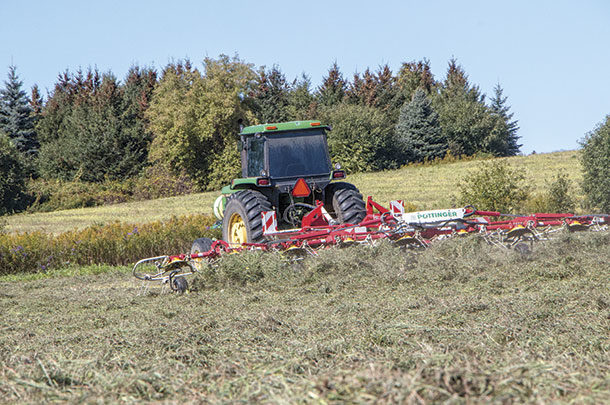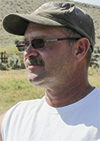Today’s producers continue to strive to produce the highest-quality hay possible. Although the age-old challenges to cut, dry, bale and store the crop as quickly as possible have not changed, production techniques and equipment continue to evolve to aid the producer in overcoming these challenges.
Dr. Dan Undersander, recently retired forage agronomist from University of Wisconsin, says, “A general principle is that, when we harvest alfalfa, it should be around 50 percent leaves and 50 percent stems – plus or minus 5 percent. Look at your bales and see if they are about 50-50, leaves to stems. If not, look to see if you left leaves in the field.”
Pre- and post-season maintenance
Timely removal of the crop is still one of the most important factors contributing to quality. In many parts of the country, the weather provides such a short window of opportunity that producers can’t afford to suffer breakdowns that could have been prevented by a good pre- or post-season inspection and maintenance.
Doug Eldred of Eldred Hay, Grain & Seed in Auburn, New York, supplies hay and straw to racetracks in the East (including the Belmont and Preakness), and says, “We are in a situation, not like it is in the West, where they are turning water on and turning water off, where we have small, two- to three-day windows where we are trying to make dry hay.”
Between haying seasons Eldred’s crew starts the pre-season maintenance with the mowers.
Eldred says, “We’ll start by draining the oil in the cutter bar. We drain them and put in new oil, and make sure there is no string or any debris stuck underneath the disks. Next, we will put on all new knives and go completely through the mowers before we put them away for the winter.”
Eldred’s crew performs the same thorough service to the rakes and tedders before moving on to the balers.
Eldred says, “We really get into the balers. My brother handles the maintenance and pre-maintenance programs.”
All of Eldred’s balers are numbered, and they keep maintenance records on each machine. Everything gets greased. All of the plungers get checked: clearances, knives, bearings and guides. Usually, they remove the plungers to make this service easier. Bearings are replaced every two years, whether they need it or not, to insure proper function. Knotters are checked for tolerances and timing.
Eldred says, “Pre-season maintenance saves on a lot of headaches and a lot of time, and maybe missed opportunities. There’s nothing worse than working on equipment when you’re trying to use it.”
Windrowers and mowers
Advances in windrowers and mowers have enabled producers to cut the crop more rapidly and condition the windrow more effectively to shorten drydown time. A new double-conditioning system, the TwinMax Advanced Conditioning System, is being released in the spring of 2018 by AGCO. This system feeds the windrow through two sets of conditioning rollers.

This double-roller system produces a stem crimp every 1 to 2 inches. In a limited study done in Idaho, the hay conditioned through the TwinMax dried down to 14 percent moisture in four days versus five, compared to the other two single-conditioner machines used in the study. A leaf retention evaluation had not been completed at the time of this printing.
Speaking of conditioner-related drydown time, some producers around the country have sought their own innovative remedies.
Joe Berney, a hay grower near Okanogan, Washington, who produces and sells premium hay to dairy, horse and beef cattle operations, and who has won numerous awards for quality hay at World Dairy Expo, has implemented multiple new innovations and ideas to produce better-quality hay.
Berney says, “The biggest thing I did is change out my conditioning rollers. We’ve run New Holland equipment since the late ’60s, so we were very familiar with the conventional conditioning rolls that came with the New Holland machines. We knew how to adjust them, and we knew when to replace them when they were worn out. I still wasn’t really happy with what I had, so seven or eight years ago, I switched to a set of custom-made rolls from B&D Rollers out of Glenwood, Minnesota.”
Berney explains that these rollers mesh 100 percent, crimping the stem from end to end completely, unlike conventional rollers that crush and break the stems at spaced intervals.
Berney says, “I have done side-by-side comparisons here. I got a different machine a couple years ago, and it had the original rolls. I ended up putting the custom rolls in it because I was back to waiting four days to bale hay. I’m two days from the time I cut to the time I bale with the custom-built rolls.”
Rakes and mergers
Every piece of equipment used to process hay can cause leaf loss to the final product. In order to expedite hay production, most producers rake hay to accelerate drying, consolidate windrows, or both. In an effort to determine how much loss is incurred through the process of raking hay, Undersander and his team took samples behind four different types of rakes. This study took place in three states over the course of two hay cuttings from the same plots.
Undersander says, “We had between 600 and 700 samples, and what we found was that about 72 percent of the difference in forage quality was due to the leaf content of the sample.”
The study showed that rotary rakes and mergers retained the most leaves, while wheel rakes and parallel-bar rakes had the lowest leaf content. There was 2 percent more loss with the wheel rakes and parallel-bar rakes than the rotary rakes and mergers. This may not seem like much, but consider that this is entirely leaf loss.
Undersander says, “So that amounts to: first, 2 percent less tonnage, and second, about 15 to 20 points of relative forage quality. Wheel rakes and parallel-bar rakes are only popular because they are cheap, and people aren’t thinking about the bigger picture.”
Balers and preservatives
Due to the stage of dryness of the hay required to safely form a bale for storage and the number of times a baler must manipulate hay to form a bale, this stage of the process can affect a large amount of leaf loss.
Undersander says, “What you can do to minimize leaf loss is basically bale the hay wetter. Baling a little bit wetter with dew or steam, or just at a higher stem-moisture content, will minimize leaf loss.”
In order to bale hay with a higher moisture content, the producer will need to apply a preservative. There are many preservative applicator options available to producers today, including systems that sense the moisture of the incoming hay and regulate the flow of the preservative to that hay.
Berney says, “I’ve started putting [preservative] on everything: first, second and third cutting. It costs between $2 and $3 per ton, but it’s cheap insurance. I got some hay rained on last year. The hay turned color, but it did not mold or heat. I believe the system has already paid for itself.”
Wheel traffic
New high-yield alfalfa varieties recover more quickly after cutting than older varieties. These varieties put out shoots much sooner than older varieties. When a truck or tractor drives over these shoots, the shoots are broken off.
Undersander says, “Our data shows that wheel traffic four or five days after mowing, like when you are picking up bales, will reduce the yield of the next cutting by 15 to 25 percent.”
To reduce this wheel traffic, many more producers are using bale accumulators to group the bales behind the baler. Bale accumulators for large square bales have been available for some time, but John Deere is now releasing a model that will accumulate and stage round bales.
Striving to produce high-quality hay will most likely be an ongoing effort by most hay growers for years to come, but with the incorporation of new methods and equipment, that goal should become steadily easier to achieve. ![]()
PHOTO 1: A worker at Eldred Hay, Grain & Seed in Auburn, New York, uses a tedder to help with drydown on late-season grass hay. Photo by Lynn Jaynes.
PHOTO 2: Management and equipment impact the final product, and new haying methods and equipment have been introduced to get us closer to the goal. Courtesy photo.
Michael Thomas is a freelance writer based in Salmon, Idaho. Emial Michael Thomas.











